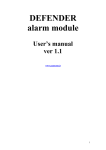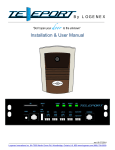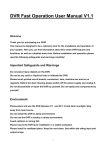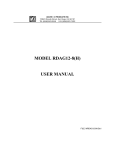Download APG7 user guide
Transcript
userguide Intrinsically safe pager, type APG7 1 APG7 INTRINSICALLY SAFE PAGER LIMITATIONS OF USE This page contains BASEEFA related information. No alterations are permitted without reference to the BASEEFA liason officer THE APG7 SERIES OF MOBILES ARE INTRINSICALLY SAFE AND MUST NOT BE MODIFIED WITHOUT PRIOR PERMISSION FROM THE CERTIFYING BODY. Classification Category 1 Rating ia, zone 0 Temperature rating.: See below (Suitable for all gas/air flammable mixtures except carbon disulphide) IP rating (protection level against the ingress of dust and liquid) 53 Main case material ambient temperature range -20°C to +40°C The polycarbonate material used to manufacture the main case together with the natural leather pouch have been selected to protect the equipment against damage, e.g. being dropped or knocked, during normal operation. These units contain no user serviceable parts, other than the battery. Units must be returned to the factory for servicing Important: The pager must be fitted into its leather pouch when used in hazardous areas Contents Introduction 4 How to use this guide 5 To prepare your pager for use 5 To insert (or change) the battery 5 Pager Controls 6 To switch your pager on 6 To reprogram your pager with identity codes, Individual (IC) or Group (GC) 7 To use your pager 9 To receive paging calls 9 To change the top display orientation when in a charging rack 9 Type: APG7*-D. Low battery 10 Out of range 10 Battery option, alkaline, To review and delete stored messages 10 Block message review 10 Individual message review 11 Blick Pt.No. 151015 must be fitted Temperature rating: T4 User selectable functions 12 To configure your pager 13 To replace the clip 20 Glossary of paging terms 22 Type:APG7*-R Battery option, NiMH, Blick Pt.No. 151026 must be fitted Temperature rating T3 2 3 Introduction APG1 and APG2 pagers are designed for use in both on-site and wide area paging systems. The robust plastic case is fitted with a removable clip that allows the pager to be worn on a belt or in a pocket. A safety cord with clip is also supplied. The APG1is an alphanumeric pager. The APG2 is an alphanumeric pager that can receive speech messages where the system licence allows. How to use this guide To perform the required task simply follow the paragraphs in the left column. To give you further information an information column appears on the right hand side of the instructions. This gives additional information for the step that you are following or, in some cases, the result of your actions. To prepare your pager for use • Pagers have a memory that can store up to 80 characters. Messages are displayed in blocks of eight characters and can be reviewed and deleted when required. Before you use your pager for the first time ... • The display can be inverted by the user so that messages are legible whichever way round the pager is worn. • The operational prompts may be displayed in any of six languages. • Fourteen different bleep tones are available. Two volume levels or silent operation can be selected. A light flashes during the call. • Each pager can be programmed with up to seven different addresses. The first address is the pager’s Individual Code number and the remaining six are Group Codes. Each Group Code can be allocated to any number of pagers to allow them to be called simultaneously. • Addresses may be entered or changed by sending special programming calls to the selected pager. Invert the pager and allow the old battery to slide out. • The pagers are powered by one AA size cell (battery); this can be either disposable or rechargeable. A rechargeable cell will be charged when the pager is placed in a charging rack. Place the new battery (size AA) into the compartment with its positive terminal facing outwards. • A low battery indication is made on the pager’s display when cells require replacement or recharging. • Vibrator (optional). • A display back light. Please ensure that the battery is new (disposable) or fully charged (rechargeable). To ensure that a rechargeable battery is fully charged place your pager in a charging rack for 14 hours. To insert (or change) the battery Press down on the battery door, slide it towards the centre and hinge it outward to reveal the battery compartment. Hinge the door over the battery, press down and slide it towards the side of the pager case until it clicks into position. The pager will bleep and display two crosses to show that it is active. 4 5 i If your pager shows: NO CODES.... You will need to program it with an Identity Code before it can be used. Please refer to your supplier for details. Pager Controls All the functions of your pager are controlled by pressing combinations of the three push buttons on the side. i information The function button When your pager was configured a number of ‘user selectable’ functions were enabled. You can access these using this button whilst in the selection mode (please refer to the section ‘User selectable functions’ for details). When you enter the selection mode the screen on your pager will show the available functions in sequence. Each option is displayed for a short period before changing to the next. Whilst a function is displayed it can be switched between the settings by pressing button ƒ. To switch your pager off Functions that can be switched on or off are selected when a tick (3) is shown and deselected by a cross (X). Press and hold If alternative settings are offered then the text indicates the choice (e.g., HIGH VOL or LOW VOL). the power button . Message button When the displays go blank, release the button. You can press receiving a call. To switch your pager on Press and hold This button controls message review. until the displays show two crosses. to cancel the bleep tone whilst To reprogram your pager with identity codes, Individual (IC) or Group (GC) You will need to be able to send programming calls from your paging encoder (keyboard) to carry out this procedure. Please refer to the encoder user guide for details. Release the button. 6 7 information i Press and hold button until the top display shows the pager's current Individual Code . Release the button. IMPORTANT: YOU FIT A NEW OR FULLY CHARGED BATTERY. FAILURE TO DO SO MIGHT RESULT IN LOST then press and release . To use your pager CODES. To receive paging calls When your pager receives a call it will bleep and display a message (and vibrate). The display will scroll through the user selectable options (e.g., The display will show BLEEP, SPEECH or a message. display, silent, volume) before The display will first show reaching PROGRAM? and then the The current Individual Code will be shown, for examlple: Individual Code. Press the message button if you wish to cancel the bleep tone whilst receiving the call. To change the Individual Code press and hold button while it is displayed. After you have received a message call you will offered the option to: Send a programming call from the paging encoder. When the new code appears release the button. If you do not wish to save the message momentarily press The pager will show the Group Codes (GC) in sequence. To add, change or delete a Group Code press and hold while it is displayed. If you do nothing your pager will store the message. The message will remain on the display until you receive another call. Send a programming call from the paging encoder To change the top display orientation when in a charging rack When the new code appears release the button. The display will change to show the next Group Code. If you wish to add, change or delete the code press and and send a programming call. hold The display will show If you do not wish to make changes do not press the button and allow the pager to return to normal operation. to indicate that your pager has returned to normal operation. 8 information BEFORE PROGRAMMING YOUR PAGER PLEASE ENSURE THAT Wait until the display shows i information To alter the orientation of the display press button during the first second of entry into the rack. The selection remains in the memory. 9 BLEEP indicates that there is no message. The sound of the bleep tone selected by the system operator is normally chosen to indicate the action that you should take. SPEECH (available on APG2 pagers) indicates that a speech message is about to be transmitted. When the bleep tone has finished you will receive the speech message. i Low battery When is displayed you must replace or recharge (as appropriate) the battery as soon as possible. To view the messages press and hold until the last message is displayed. Release the button. The pager will display all the messages in sequence. NOTE: You must never place a pager with a DISPOSABLE battery in a charging rack. Out of range If this option was selected during configuration your pager will bleep and display RANGE? if you are out of range of the transmitter for more than 40 seconds. Your pager will continue to display RANGE? until it receives a valid transmission. Other active pager functions will be displayed alternately. To review and delete stored messages The message store has a capacity of 80 characters. When the store is full, new messages will overwrite the existing ones, starting with the oldest. You can set your pager (see 'User selectable functions', page 11) to review messages using either of two options: a b Block message review. When you initiate the message review your pager will display all the stored messages in sequence. If you choose to delete then all messages are cleared from the store. i information When all messages have been displayed the pager will show: Press the message button momentarily if you wish to clear all messages from the store. information If you wish to pause the display press and hold The number of each message is shown on the display. If you do not delete the reviewed messages the displays will show the number of stored messages. NOTe If you switch your pager off or place it in a charging rack (rechargeable batteries only) all messages will be deleted. Individual message review Display backlight When stored messages are reviewed the display will be illuminated automatically. The default message review method is set during pager configuration (p13). If you select the alternative then your pager will revert to the default when you next switch it on. (User selectable option) Press the message button stored messages. to display the number of Press the message button again to display the individual message number, starting with the oldest. The display will show: The display will show: Hold the button in to scroll through the message numbers. Release the button when the message that you wish to see is shown. The display will show: When the message has been shown you will be offered the option to delete it. The display will show: Press the message button to delete the message. The display will show: Individual message review. This option allows you to review and delete any stored message. Block message review (User selectable option) Press the message button stored messages. to display the number of 10 momentarily if you wish When no messages are stored then the displays will show: 0 M NOTE If you switch your pager off or place it in a charging rack (rechargeable batteries only) all messages will be deleted. 11 i User selectable functions You can customise some of the functions of your pager to suit your own requirements. This can be done at any time. The following is a complete list of the functions. You will only see those functions made available to you when your pager was configured. To change the setting of a function press display. i information Message review method whilst it is shown on the (select individual) (select block) Each time you press the button the setting will change. Program Programming instructions can be found on page 7. If you wish to program an identity code (Individual or Group) press and follow the instructions on page 5. Otherwise allow the pager to continue through the selection sequence. To access the selection mode This facility allows you to join (or leave) any of the groups programmed into your pager. Each of the programmed groups is displayed in sequence. Press button ƒ to make your choice. User groups Press and hold button until the individual code is displayed then release it. The pager will show the available functions in sequence. Press button ƒ only if you wish to make a change. Display orientation When you have finished your pager will return to normal operation. This inverts the display to make it easier to read wherever you wear your pager. You can stop your pager from bleeping whilst receiving a call. If you select SILENT the word will be displayed alternately with other active pager functions e.g., RANGE, LOW BATT. Silent mode This selection will lengthen the bleep period to 24 seconds. You can still cancel the tone in the normal way by pressing the message (bottom) button. Long ID Bleep volume Two bleep volume levels are available. 12 This screen will allow you to choose message review facility. Select a tick to use BLOCK MESSAGE review or a cross to review INDIVIDUAL MESSAGES. If you switch the pager off it will revert to the default setting the next time that it is switched on (the default is set during pager configuration - see below). If you do not press the button for a short while the pager will move to the next function. Several functions are set as configuration defaults in the factory. The headings for these are in normal text. The remaining functions are shown in italics. The user functions are shown on the TOP display. The front display will show the last received message (if any). information To configure your pager These procedures allow you to set the engineering functions of your pager to allow it to operate with your paging system and to select user functions. WARNING If your are not sure how to set these engineering functions please refer to your supplier. If you make an invalid setting your pager might not work. You must delete all identity codes from your pager before you can change the configuration. 13 i To delete all codes Press and hold button until the top display shows the pager's current Individual Code. i information You will need to be able to send programming calls from your paging encoder to carry out these procedures. Please refer to the appropriate user guide for details. To change the format and program codes without altering the configuration. information IMPORTANT: Please ensure that the battery is fully charged (rechargeable) or new (disposable) before programming the identity codes otherwise they might not be saved to memory. Press and release button Release the button. The display will show the current format setting e.g., Allow the pager to go through the user selections. Wait until the display shows then press and release . IMPORTANT: Please ensure that the battery is fully charged (rechargeable) or new (disposable) before programming the identity codes otherwise they might not be saved to memory. Whilst the format is displayed, each time you press the format will change. Release the button when the required format is displayed. FORMAT is normally set in the factory from the ordering specifications. The FORMAT letter shown MUST correspond to the format setting in the system encoder otherwise the pager will not work. A, B and C represent the three coding formats. Format C is the default Blick setting. A and B can be used for specific systems (please refer to your supplier before using these options).. The display will first show The display will show IC (Individual Code). then the individual code. Press and hold button Press and hold Send a programming call for the required Individual Code from the system encoder. Send a DELETE ALL programming code from the system encoder. When the new code appears release the button. The display will show: Refer to the section To configurethe pager and program the identity codes for details. Your pager is now ready to be configured. The pager will show the Group Codes (G1 to G6) in sequence. Continued on next page 14 15 This will store the new format setting i i information information Continued from previous page To add a Group Code press while it is displayed. Send a programming call for the new code from the system encoder. then, after a short while, the first 8 function codes (shown in the table). for example, This will store the new code When the new code appears release the button. The display will change to show the next Group Code. If you wish to add another code press programming call. and send a Release the button to reveal those remaining., for example, This will store the new code The pager will now show the available function options in sequence. Press button only if you wish to make a change. If you do not wish to make changes do not press the button and allow the pager to return to normal operation. LANGUAGE The language options are automatically shown in sequence. When your required language is displayed, press and release button To configure the pager and program the identity codes IMPORTANT: Please ensure that the battery is fully charged (rechargeable) or new (disposable) before programming the identity codes otherwise they might not be saved to memory. then switch the pager on. Press and hold button The pager will display the software title, for example, press whilst it is shown on the display. Language for prompts: E, English; D, Dutch; N, Norwegian; F, French; G, German; I, Italian RANGE This function, if selected, will cause the pager to bleep and display RANGE? if no valid transmission has been received for approximately 40 s. Other active pager functions will be displayed alternately. The RANGE facility must also be selected in the system encoder. LED (Light) To prevent the LED from illuminating select X for this option. POWER Select this option to prevent the pager being switched off. Continued on next page 16 NOTE: Where a dash appears on the display the function is disabled. If you select SILENT the pager will not bleep on receipt of a call. The light will still flash, unless it has been disabled (see 'light' below) Each time you press the button the setting will change. If you do not press the button for a short while the pager will move to the next function. Block 2 position: 1 = 2 - 6 (Decode algorithm) 2 = B (Block message) 3 = U User groups 4 = V (Vibrate) SILENT Switch the pager off To change the setting of a function Block 1 position: 1 = E, D, N, F, G, I (Language) 2 = S (Silent) 3 = R (Range) 4 = L (Light) 5 = P (Switch) 6 = A, B, C (Format) 7 = 0 - 8 (0 to 8 errors) 8 = L ( Long Bleep) 17 i i information information Continued from previous page FORMAT is an engineering function and is normally set in the factory. The format letter shown MUST correspond to the format setting in the system encoder. The default setting is C. FORMAT The display shows a number between 0 and 8 which indicated the number of non-correctable errors that are permissible in each message block before a message is rejected as unusable. If a message is rejected in this way the call is disregarded and the pager does not respond. Corrupted characters are shown as blanks. ERRORS (error level) IMPORTANT Send a programming call for the required Individual Code from the system encoder. Select this option to allow the user to choose either the normal bleep time, 5 s or a long bleep time, 24 s. The pager will accept a maximum of 6 group codes. When the new code appears release the button The pager will show the Group Codes (GC) in sequence. To add a Group Code press LONG ID (long bleep) while it is displayed. Send a programming call from the system encoder. This is an engineering function only and must be set to 6. BITSPRE (decode algorithm) BLKMESS (default message review method) Block message review allows all the messages in the store to be read at once in sequence. If the offer to DELETE? is accepted then all the messages are erased. This screen will allow you to set the default message review facility. Select a tick to default to BLOCK MESSAGES or a cross to default to INDIVIDUAL MESSAGES. You can temporarily change the setting from the "user selectable functions" (page 9). If you switch the pager off it will revert to the default setting the next time that it is switched on. When the new code appears release the button. The display will change to show the next Group Code. If you wish to add another Group Code press send a programming call. Individual message review allows individual messages to be selected, read and deleted. Select USRGRPS to allow the user to join or leave any of the groups programmed into the pager. VIBRATE This selects the vibrator (where fitted). 18 and If you do not wish to make changes do not press the button and allow the pager to return to normal operation. USRGRPS (user groups) This will save the settings. 19 This will save the settings. i To enter the open channel mode Open channel is a diagnostic mode that allows the pager to display information from all transmitted calls. This is a 3 digit information code followed by the identity code of the pager being called. Switch the pager off. Press and hold button . button and then press the power i information The pager will display its software title and, after a short while, the first 8 function digits. To fit the new clip hold it 90° to the pager case and insert it into the aperture. Lift the locking tab, and whilst applying pressure, and rotate the clip clockwise until it “clicks” into position. The remainder of the function digits are displayed and the pager will enter the open channel mode. Release the buttons. Please note: To return to normal operation momentarily press the power button . Under certain circumstances your pager can be subjected to electrostatic discharge. This can cause the unit to reset and go through the start-up sequence before returning to normal operation. To replace the clip Place your thumb on top of the clip and, using a screwdriver, pull the locking tab away from the pager body. The thumb pressure avoids placing too much strain on the clip mounting. Whilst pressing the clip towards the pager body, rotate it anticlockwise by 90° and gently pull it away from the case 20 information 21 Never rotate the clip without lifting the tab as you will damage the case. Glossary of paging terms Bleep Used to describe the sound made by a pager when called (also bleeptone, bleep-sound). Group Code A number shared between pagers allowing them to be called simultaneously. Individual Code A number representing the unique identity of a pager allowing it to be called selectively. Pager configuration The process of selecting those pager functions that will be available to the user. This normally forms part of system commissioning. Pager programming The procedure required to enter or change pager identity codes (individual and group). Open channel A diagnostic mode that allows a pager to receive all calls transmitted on a system and display the results in code. 22 23 Blick Communications Limited 15 Cofton Road EXETER Tel: 01392 204100 Devon FAX: 01392 204170 England EX2 8QW www.blickcommunications.com International tel: International FAX: +44 13 92 20 41 00 +44 13 92 20 41 70 Issue 3 Part number 010696 24





















